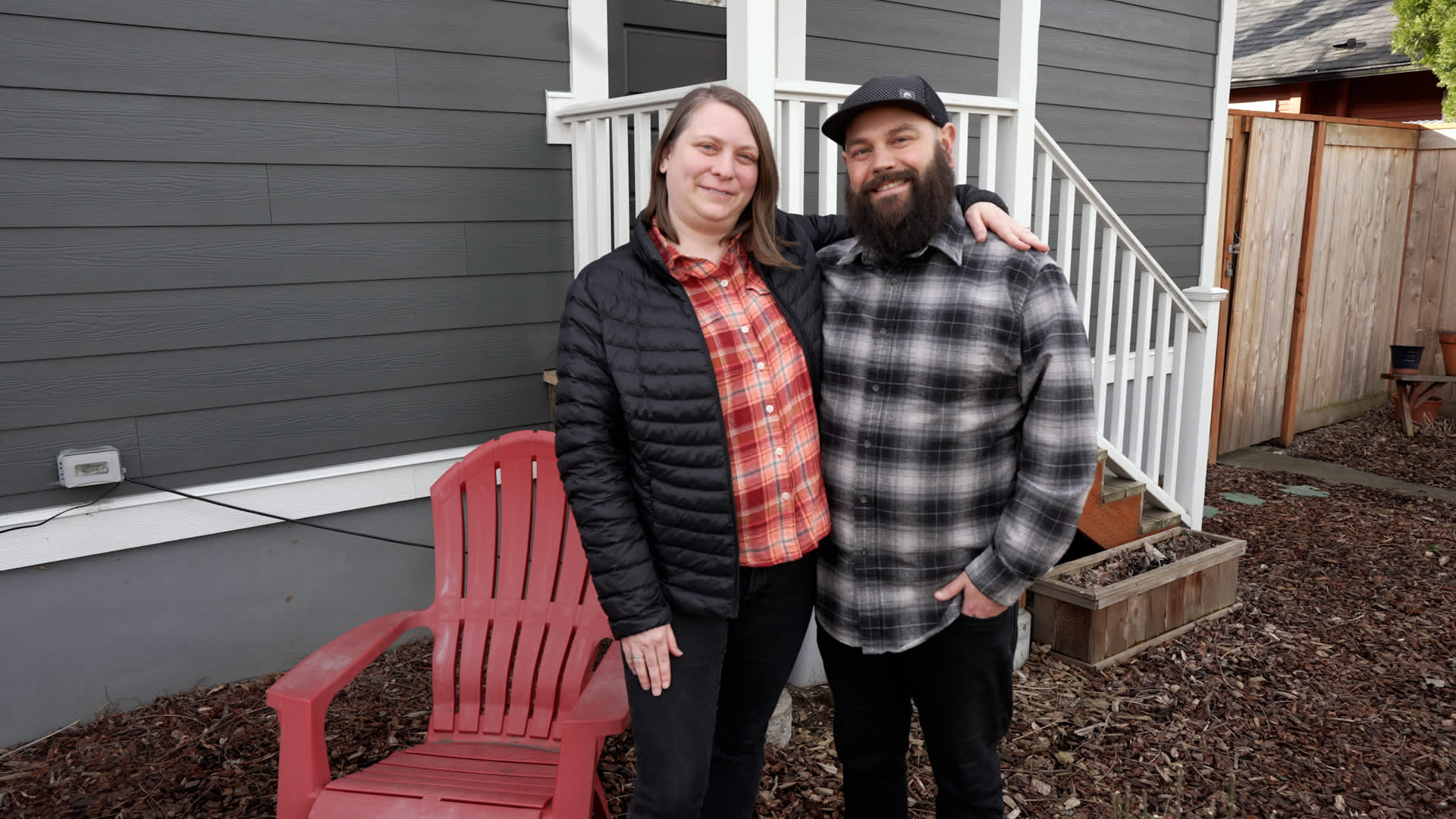When Ryan Shanahan, 41, decided to buy a house in Portland, Oregon, he knew from the start that he wanted his future home to be “net zero.”
To be net zero is to cut greenhouse gas emissions to as close to zero as possible, with any remaining emissions reabsorbed from the atmosphere, by oceans and forests, for instance, according to the United Nations.
“My mantra is that the future is efficient, electric, and renewable,” Shanahan tells CNBC Make It. He is a zero-energy retrofits manager at Birdsmouth, a zero-energy housing company.
He advises clients on how to convert their existing property into a net-zero building.
Ryan Shanahan and Megan Milligan spent $48,325 to retrofit their home.
Zachary Green. Photo by CNBC Make It
In 2014, Shanahan purchased a 116-year-old two-bedroom, one-bathroom house for $275,000.
For him, it was the best option because it already had some of the design features needed to help reach his goal of making the house zero energy:
- The house is a rectangle shape with the long side facing south, which is great for energy efficiency
- The structure also has a south-facing roofline, which is ideal for solar power.
To buy the house, Shanahan took advantage of a $15,000 forgivable loan from Oregon’s Down Payment Assistance program. The program helps Oregonians buy homes with assistance from the state’s approved mortgage lenders.
Shortly after Shanahan bought the house, his partner, Megan Milligan, 39, an office manager at Renewable Northwest, moved in.
The couple’s monthly payments add up to $2,014, including tax and homeowner’s insurance.
Shanahan purchased the house because it had design features needed to help reach his goal of making the house net zero.
Zachary Green. Photo by CNBC Make It
In 2019, the couple started a 3-month journey to retrofit the house to net zero
Shanahan and Milligan were able to save some money on renovations because they did a lot of the demolition work themselves.
In total, the couple spent $61,325 retrofitting the house:
- Insulation: $10,000
- Air sealing: $150
- Heat pump: $12,000
- Heat pump water heater: $950
- Energy Star appliances: $2,900
- LED light bulbs: $25
- Solar panels: $30,000
- New electric system: $3,500
- HEPA air filters: $1,800
That number was reduced to $48,325 after the couple received several tax credits, rebates and incentives from the state of Oregon and the federal government.
Shanahan and Milligan took out a $100,000 home equity line of credit, or HELOC, for the renovations, which has an interest rate that is higher than usual, according to the Oregon State Credit Union.
The couple allots $1,250 a month to pay down the credit as fast as possible.
Shanahan and Milligan were able to take advantage of several tax credits, rebates, and incentives from the state of Oregon and the federal government.
Zachary Green. Photo by CNBC Make It
In 2019, their electricity costs totaled $1,100. The couple installed solar panels in 2020, and their electricity costs dropped to $285.
Shanahan said the amount of sunlight the house receives and the position of the solar panels meant that after one year of a net-zero house, they were able to produce 110% of the energy they use.
They were producing 10% more energy than they were using.
The couple have now started using the energy surplus to charge their electric car.
Zachary Green. Photo by CNBC Make It
The couple uses that 10% surplus to charge their electric car. Since getting the car, Shanahan said, they did have to start paying for electricity again — but not much.
Shanahan and Milligan have no plans to change their net-zero lifestyle. Assuming the cost of energy goes up 4%, Shanahan estimates that the investments they’ve made in the house will pay for themselves by year 16 or 17 of their 30-year mortgage.
“We’re in it for the run long at this point. We’ve invested so much and we love this home,” Milligan said.
To be more energy efficient, “start with the small stuff,” Shanahan says. “If you’re buying a new stove, buy the electric version. Get the efficient version. Capture the available incentives that exist because if you put it all together, you could actually get somewhere.”
DON’T MISS: Want to be smarter and more successful with your money, work & life? Sign up for our new newsletter!
Check out:

